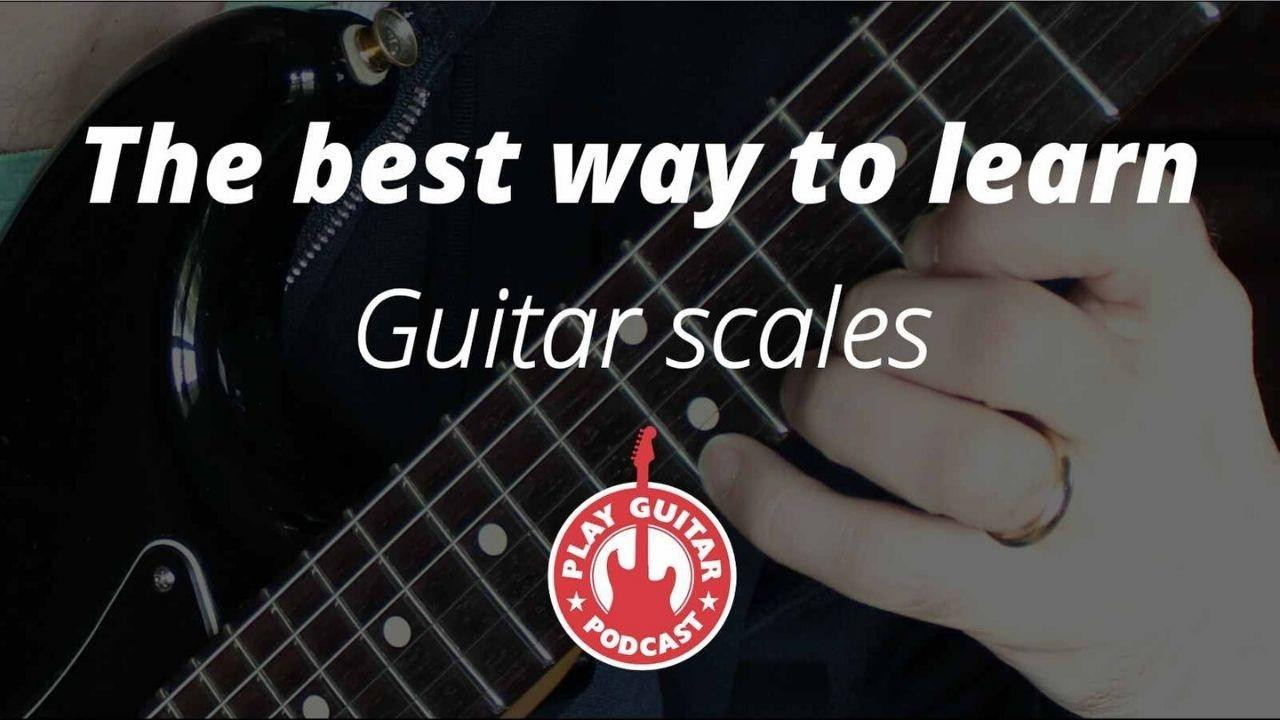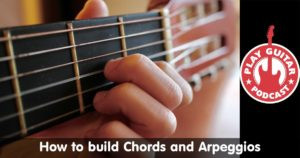
Welcome to your comprehensive guide on how to Learn Guitar Scales effectively! If you’re like many guitarists who’ve dabbled in scales but feel stuck, you’re in the right place. I’ve noticed a recurring theme with my students who try to learn guitar scales on their own: frustration. They often know scale patterns but struggle to apply them musically.
Over years of teaching, I’ve consistently addressed the same fundamental questions to help guitarists break through these plateaus. This led me to develop my “Six-Step Plan to Learning Guitar Scales,” a structured approach focusing on the why and how behind scale mastery.
Initially, I intended to share this plan in a single blog post. However, as I delved deeper, I realized the depth of information required a more digestible format. Therefore, I’ve divided this guide into a series of easily readable posts.
In this first installment, we’ll lay the groundwork by exploring the six essential concepts you must understand to truly learn guitar scales. We’ll then dive into the first three crucial steps of the plan. The remaining steps will be covered in subsequent posts, so stay tuned!
What’s the Best Way to Learn Guitar Scales?
Most beginners are drawn to the guitar by the allure of strumming chords. But inevitably, the desire to play melodies and captivating guitar solos emerges.

The magic of soaring electric guitar solos and beautiful acoustic melodies is incredibly appealing. They sound effortless and full of expression.
But…
…Embarking on the journey to become a lead guitarist can be challenging, especially without a clear roadmap! Many aspiring lead players get excited, learn a few minor pentatonic or major scale patterns, and then hit a wall. They can mechanically play the patterns up and down but soon realize that simply knowing the shapes isn’t enough to create compelling music.
That’s when I often step in and say, “Hold on a minute!”
“Before we jump into using these patterns to craft solos, there’s crucial foundational knowledge we need to grasp.”
To truly unlock the potential of scale patterns, you must understand WHAT they are and WHY they work. This understanding is the game-changer.
This is the secret weapon of your guitar heroes. It’s how they effortlessly create licks that sound amazing and uniquely their own, never sounding like mere copies of other players.
So, let’s explore this vital information. I guarantee it will put you on the fast track to lead guitar success!
My proven method for guiding students to understand and effectively use guitar scales is this six-step plan:
- Master the Guitar Fretboard Layout
- Understand the Essence and Construction of Scales
- Identify the Ideal Scales for Your Musical Style
- Break Down Scales into Manageable Patterns
- Practice Scale Patterns Over Chord Progressions
- Transpose Scale Patterns to Different Keys
I’ve witnessed countless students experience their “aha moment” as they progress through these steps. It’s like turning on a light in a dark room – suddenly, everything clicks, and the path forward becomes clear. If you’re struggling to grasp how scales function on the guitar, keep reading to begin your journey through this insightful and practical plan.
Step One: Master the Guitar Fretboard Layout.

One of the very first lessons I impart to all my new guitar students is fretboard navigation.
At first glance, the guitar fretboard can seem intimidating. So many notes spread across six strings! It might appear as a random collection of notes.
But that couldn’t be further from the truth.
The guitar fretboard is logically organized. Once you grasp a few fundamental principles, it all falls into place.
I recently published a detailed article, “How to Learn Guitar Notes on the Fretboard.”
It comprehensively covers the essential concepts for understanding the fretboard:
- The Musical Alphabet
- Notes on a Single String
- Fretboard Repetition
- String Overlap Points
- Simple Octave Shapes for Fretboard Navigation
If any of these topics are unclear or you need a refresher, I highly recommend quickly checking out this article.
==>> How to Learn Guitar Notes on the Fretboard
Welcome back! Hopefully, it’s now clear that the guitar’s layout is logical. Understanding the chromatic scale and how notes on adjacent strings relate and overlap makes it possible to locate any note on the fretboard.
It’s also evident that the guitar has a vast number of notes, making it challenging to visualize them all simultaneously. This is where understanding scales becomes invaluable.
Step Two: Understand What Guitar Scales Are and How They Are Built
Let’s begin by defining what we’re actually working with. In its simplest form…
…a guitar scale is a sequence of musical notes, typically played in ascending or descending order of pitch, that sound harmonious together. They “match” or complement each other musically.
While scales are often practiced in ascending and descending patterns, this isn’t how they’re most effectively used in music. In melodies, guitar solos, bass lines, and countermelodies, scales are used more dynamically, jumping between notes to create musical phrases. A melody that simply runs up and down a scale would lack musical interest.
Scales are distinct from chords.
The notes within a scale are intended to be played sequentially, one after another. This contrasts with chords. Like scales, chords use groups of harmonically related notes, but chord notes are designed to be played simultaneously.
If you’re unfamiliar with chords or want to deepen your understanding of chord construction, I have an article dedicated to explaining chords and their formation.
You can find this companion article here:
==>> How to Build Chords and Arpeggios on Guitar
Chords and scales are interdependent. Typically, rhythm instruments playing chords provide harmonic support for melodic instruments playing scales. Chord progressions establish a tonal center, and melody instruments utilize scales that complement those chords.
How Guitar Scales Are Constructed
Not every combination of notes sounds pleasing together. There are specific reasons why certain groups of notes “match” harmonically. Different scales have distinct sounds and musical functions because of their unique construction.
The best way to understand scale construction is to dive right in and build one! Let’s construct a C Major scale entirely on a single string.
Let’s Build a Scale on Your Guitar!
- To build our first scale, we’ll start with the note C. Play this note on the 3rd fret of the A string. This is our “tonic” note – the foundational note of the scale and the key we’re in. We’ll label this note number 1.
- Next, move up to the 5th fret (two frets higher) on the same string and play that note. This is a D, and we’ll label it number 2.
- Continue to the 7th fret. This note is an E, labeled number 3.
- Now, move up just one fret to the 8th fret. This is an F, labeled number 4.
- Move up two more frets to the 10th fret. This is a G, labeled number 5. Keep going – just three more notes!
- Move up two more frets to the 12th fret. This is an A, labeled number 6.
- Move up two more frets to the 14th fret. This is a B, labeled number 7.
- Finally, move up one fret to the 15th fret. This is a C, the same note we started with, but an octave higher. We’ll label this number 1 again.
How does it sound? Familiar? You’ve just built a C major scale. Many recognize this as the “Do Re Mi Fa Sol La Ti Do” scale from vocal exercises or “The Sound of Music.”
How did we do it? Starting from a root note (C), we proceeded in order, moving up either one fret or two frets to each subsequent note in the scale.
Knowing when to move one fret and when to move two is the key to constructing well-sounding scales. To understand this, we need to learn about intervals.
What is a Musical Interval? (Half Steps and Whole Steps)
An interval is a fundamental concept in music theory.
Simply put, it’s the distance between two musical notes. There are many different intervals, each with a unique sound and distance. They have specific names that describe their sonic character.
For our immediate purpose of scale construction, we’ll focus on two intervals: the Major 2nd and the minor 2nd.
On the guitar, a Major 2nd interval corresponds to a distance of two frets (commonly known as a whole step).
A minor 2nd interval on the guitar is a distance of one fret (commonly known as a half step).
Notice that when we built the C Major scale, we only moved by either one or two frets between notes. These are our half steps and whole steps in action.
Different scales are defined by unique patterns of half steps and whole steps. This pattern is what gives each scale its distinctive sound.
In the next post, we’ll explore the specific patterns of half steps and whole steps that define the scales most relevant to playing the music you love.
(If you’re interested in a deeper dive into intervals, stay tuned for my upcoming article dedicated to intervals and their application on the guitar.)
Step Three: Know the Best Guitar Scales for Your Music Style
There is a vast world of guitar scales. Throughout my guitar journey, I’ve explored and learned many.
While I occasionally utilize a wide range of scales, I’ve found that certain scales are particularly suited to specific musical styles.
Today, I’ll concentrate on the scales most commonly used in popular music genres:
- Rock
- Hard Rock
- Country
- Blues
- Southern Rock
- Pop
- Soul
- R&B, and more.
I plan to dedicate future articles to the best scales for other musical genres. I will link to them here as they become available.
Essential Guitar Scales for Popular Music
When playing or teaching popular music, I consistently emphasize the “Big Four”:
- Major Scale
- Natural Minor Scale
- Major Pentatonic Scale
- Minor Pentatonic Scale
If you listen to popular music, you’re already familiar with the sounds of these scales.
The Major Scale has a bright, happy sound. It’s often associated with the “Do-Re-Mi” melody.
The Natural Minor Scale is the go-to scale for creating sad or melancholic sounds. It’s also prevalent in many hard rock compositions.
The Major Pentatonic Scale is a simplified Major scale. It’s widely used in Country, Southern Rock, Soul, and some Blues styles.
The Minor Pentatonic Scale is a simplified Natural Minor scale. It’s a cornerstone of Blues and Rock music.
Achieving comfort and fluency with these “Big Four” scales across the guitar neck provides the essential foundation for playing lead guitar in popular music.
But their benefits extend beyond soloing! Knowing these scales also significantly aids in music reading, songwriting, crafting and learning vocal melodies, vocal harmonies, and bass lines.
Be sure to check out Part 2 of this guide. There, I’ll delve into each of the “Big Four” scales in detail.
We’ll break down each scale to understand:
- Its characteristic sound
- Its construction (intervals and patterns)
- When to effectively use it in your playing
Another excellent resource for getting started with scales is Justin Sandercoe’s Scales Index page. I highly recommend exploring his scale basics and commonly used scales sections.
==>> Justin Guitar Scales Index Page
Thank you for reading Part 1 of my Six-Step Guide to the Best Way to Learn Guitar Scales!

It’s often said that “a little knowledge goes a long way.” This is particularly true when it comes to learning guitar scales.
Simply memorizing scale patterns provides an incomplete picture.
The information presented in this post, and the upcoming parts, will provide the crucial knowledge you need to use scales effectively and musically in your own playing!
Coming Soon: Part 2!
GET FREE WEEKLY GUITAR LESSONS, PODCASTS, AND MOTIVATION DELIVERED STRAIGHT TO YOUR INBOX.
Your information is always kept safe and never shared with third parties.

 Guitar Chords and Arpeggios
Guitar Chords and Arpeggios